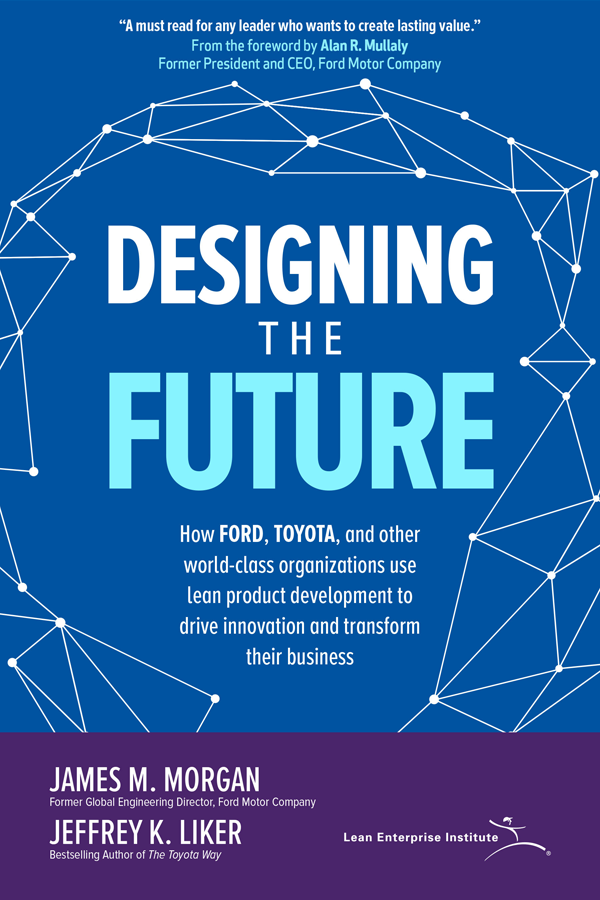A key practice that separates lean product and process development (LPPD) from other approaches to innovation is that LPPD is an enterprise activity, not an engineering-only activity, according to LPPD author, researcher, and former product development executive Jim Morgan. Properly implemented, LPPD creates a collaborative, transparent environment where the entire enterprise – manufacturing, marketing, service, supply chain, etc., comes together to focus on creating value for customers.
In an interview with Steven Wilson, a strategic advisor at Iowa State University’s Center for Industrial Research and Service, Morgan was asked about the challenges companies face in making innovation an enterprise-wide endeavor along with other critical issues in developing new products and services. The interview text was edited for length. Listen to the full audio version here.
Jim: Unlike say, working in manufacturing where it’s possible to have a significant impact in pockets of excellence, it’s really important in product development to engage senior leadership to bring the enterprise together, meaning supply chain, manufacturing, and marketing along with design and engineering. That can create some difficulties especially in organizations that are highly siloed. But those are the organizations that need this the most because LPPD helps to break down those silos to bring these functions together.
Steven: In Designing The Future, the book you wrote with Jeff Liker, you describe the matched-pair strategy. Can you elaborate on that for us?
Jim: One of the key alliances in product development is aligning engineering with your supply-chain professionals because suppliers create so much value in product development. For instance, in the auto industry, depending on the company and the vehicle, suppliers provide around 60% of the total vehicle content. And so, it’s crucially important that you have a strong relationship with your suppliers. You make them part of your extended enterprise.
It turned out to be an extremely powerful strategy. Within a couple of years, we were second only to Toyota in our relationships with our suppliers.
At Ford, we “matched up” similar level people in the supply chain organization with the engineering organization to align objectives and how we create value. For example, in my old role as Ford’s global director for body safety and stamping, I was matched with Susan Desandre, who was the global purchasing director for raw materials and commodities. Together we owned cost targets, long-term strategies, plus commodities and components. As you went through our organization there were similar match-ups.
Together we visited suppliers so we could speak with one voice and more importantly, listen together to what we were hearing from our suppliers. It turned out to be an extremely powerful strategy. Within a couple of years, we were second only to Toyota in our relationships with our suppliers.
Steven: I love it. It interests me because from the very beginning of lean or the Toyota Production System respect for people has always been a pillar. Why do organizations oftentimes struggle with that?
Jim: One reason is that the “what” is always so urgent, right? We have to have this product out by this point, or we have to produce a vehicle every 53 seconds. And sometimes it causes us to lose awareness of the “how.”
I think the other reason is that “people” stuff is challenging and hard to measure. It’s hard to have meaningful KPIs, so to speak, on the “how”. We do things like engagement surveys or we’ll do 360-degree surveys to get feedback. But I think most organizations struggle with understanding how to measure respect for people. We get so caught up in achieving metrics that we lose sight of it. We tend to get caught up in what’s measurable and what’s urgent at the moment.
Steven: One of the things that you focus on is this notion of driving out fear, a concept contained in Deming’s 14 Points. How much of a role does fear play in our workplaces today?
Jim: The longer I work at this, the more I recognize the wisdom in many things that Deming taught us. Fear holds back organizational learning more than any other element. Oftentimes when companies talk to me about organizational learning, they’re looking for the tool, they’re looking for the technology that’s going to make them more effective in gathering information and then reapplying it as they go forward.
But I would argue that the biggest limitation in learning is fear in your organization. Fear of failure, fear of just saying, “I don’t know. Let’s do the experiment and see what we learn.” Fear of being wrong, of having a failed experiment. I think those are the things that really hold back learning. Leadership is absolutely crucial in setting the tone and creating the right environment for people to collaborate, learn, and move the whole organization forward.
Steven: One of the things that I’ve seen is that there’s a fear in leadership as well.
Jim: For sure. One of the leaders I admire most and one of my mentors was Alan Mulally. He set the tone at Ford, changed the culture in the time that he was there, and enabled people to fully collaborate.
He had what he called a people-first leadership style. In interviewing him for Designing the Future with Jeff we asked, “What exactly does that mean?” His answer stunned me.
“It means I love you as a person,” he said. “And I care about you, and I care about your experience with the company. We need to create a culture where the ‘how’ matters just as much as the ‘what’”.
Working that way, he was able to inspire people to do more and be more than they ever thought possible.
Steven: That goes right back to one of the principles of lean management, respect for people.
Jim: And for people’s talents; for creating an inclusive environment where everybody can contribute, where there’s one team, one focus on how we’re going to create value and how we’re going to design the future of the organization. That’s the power of working in product and process development; the work you do and the decisions you make during the development process are truly creating the future for the organization.
To be effective, you need to embed lean principles and practices into the way you do your work as opposed to it’s what we do every other Friday when we have our lean meeting
Jim Morgan
Steven: One of the things I have seen and I’m sure you have, is a lot of organizations do lean, but it’s not a way of life, it’s not a way of doing business.
Jim: To be effective, you need to embed lean principles and practices into the way you do your work as opposed to it’s what we do every other Friday when we have our lean meeting. And it’s true in product and process development and with management systems. A lot of people say, “We did A3s, we did obeya, we did value-stream mapping. It didn’t work here.” I struggled to understand what was behind all that because I knew they were incredibly effective tools. These companies were doing their best to implement LPPD, but they just weren’t having the effect.
So, I looked at this problem in sort of a microcosm by just looking at management systems. I concluded that there are two critical elements to an effective management system, which you can then extrapolate to other lean processes. The two elements are your operating system, which are your tools and specific practices, times leadership behavior. (See The Formula for a Successful Management System: LB * OS = MS) Those two [leadership behaviors and operating system] together create an effective management system.
If you use tools like obeya or visual management, but then every time somebody raises an issue, they get a wire brushing from leadership then pretty soon nobody’s going to surface issues, right? The combination of appropriate leadership behavior and the tools are equally important. You need to work on improving both simultaneously.
Steven: One of your topics that piqued my interest was this notion of how to check the quality of an A3. What are you referring to?
Jim: That’s something I learned from one of my colleagues at the Lean Enterprise Institute, Eric Ethington, who is the project manager for our LPPD effort. Eric teaches A3 classes and has been working in this space for a long time. He suggests reading your A3 backward [from the right side to the left] to see if it sticks together.
Often the left-hand side of an A3 doesn’t talk to the right-hand side; you don’t see the connections between the countermeasures [right side] that you’re going to experiment with and the basic problem analysis [left side]. By reading it backward and saying, “Our hypothesis is that if we experiment with these particular countermeasures, we will help close the gap from the current state to the future state.” If that doesn’t resonate with you, if that doesn’t seem logical, then maybe it’s time to rethink your A3.
Many times, when people move from the left-hand side to the right-hand side of an A3 they are creating, they get so caught up in the countermeasures, they lose sight of what problem they started out to solve.
Steven: Any closing comments? Anything on your mind or your heart about lean continuous improvement?
Jim: The book The Machine That Changed the World by Dan Jones, Jim Womack, and Dan Roos introduced Western culture to this idea of lean. Right from the beginning, they talked about the lean enterprise, product development, and supply chains. For some reason, we’ve focused more on the manufacturing side of lean. I think it’s great we’re talking about using product development as what can bring a company together into a lean enterprise.







